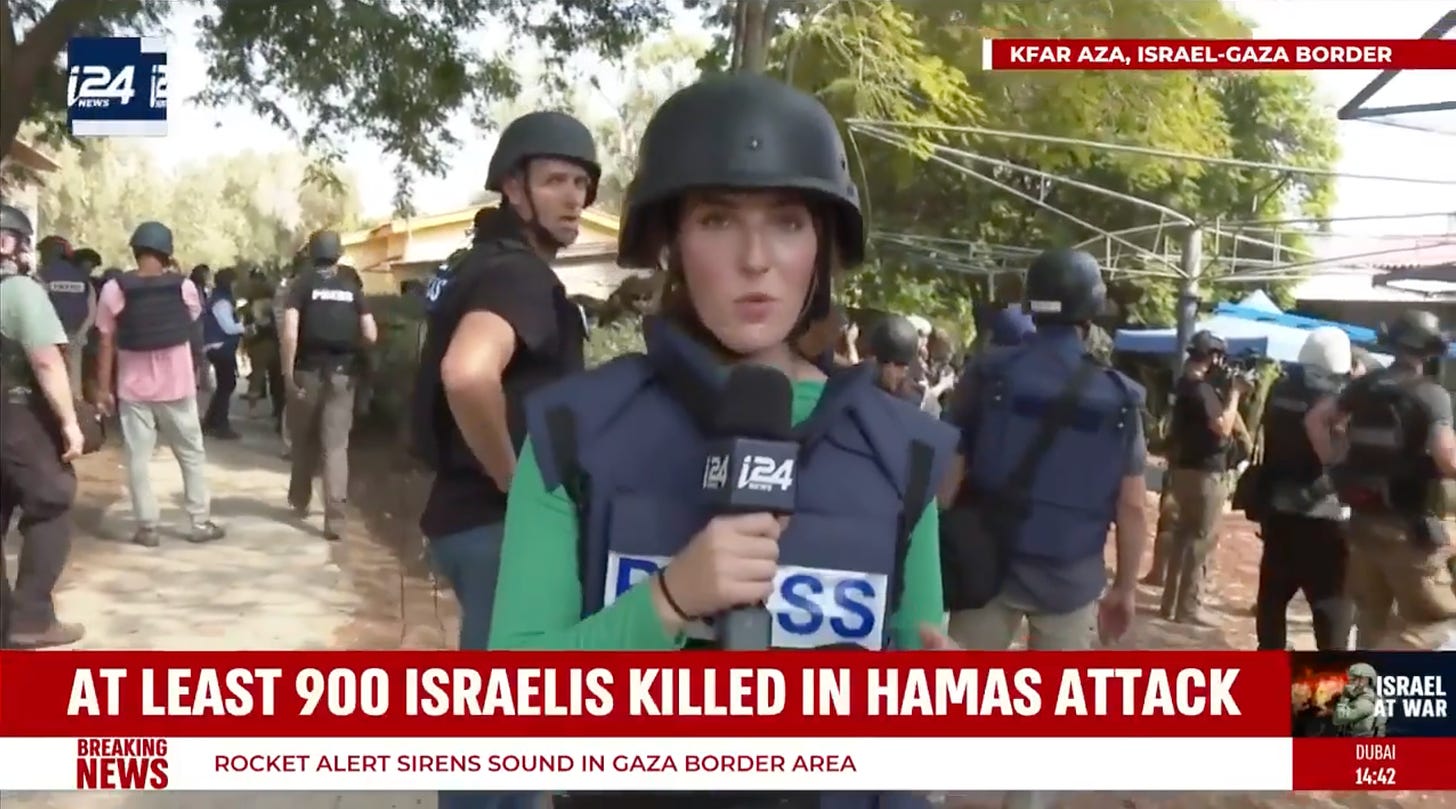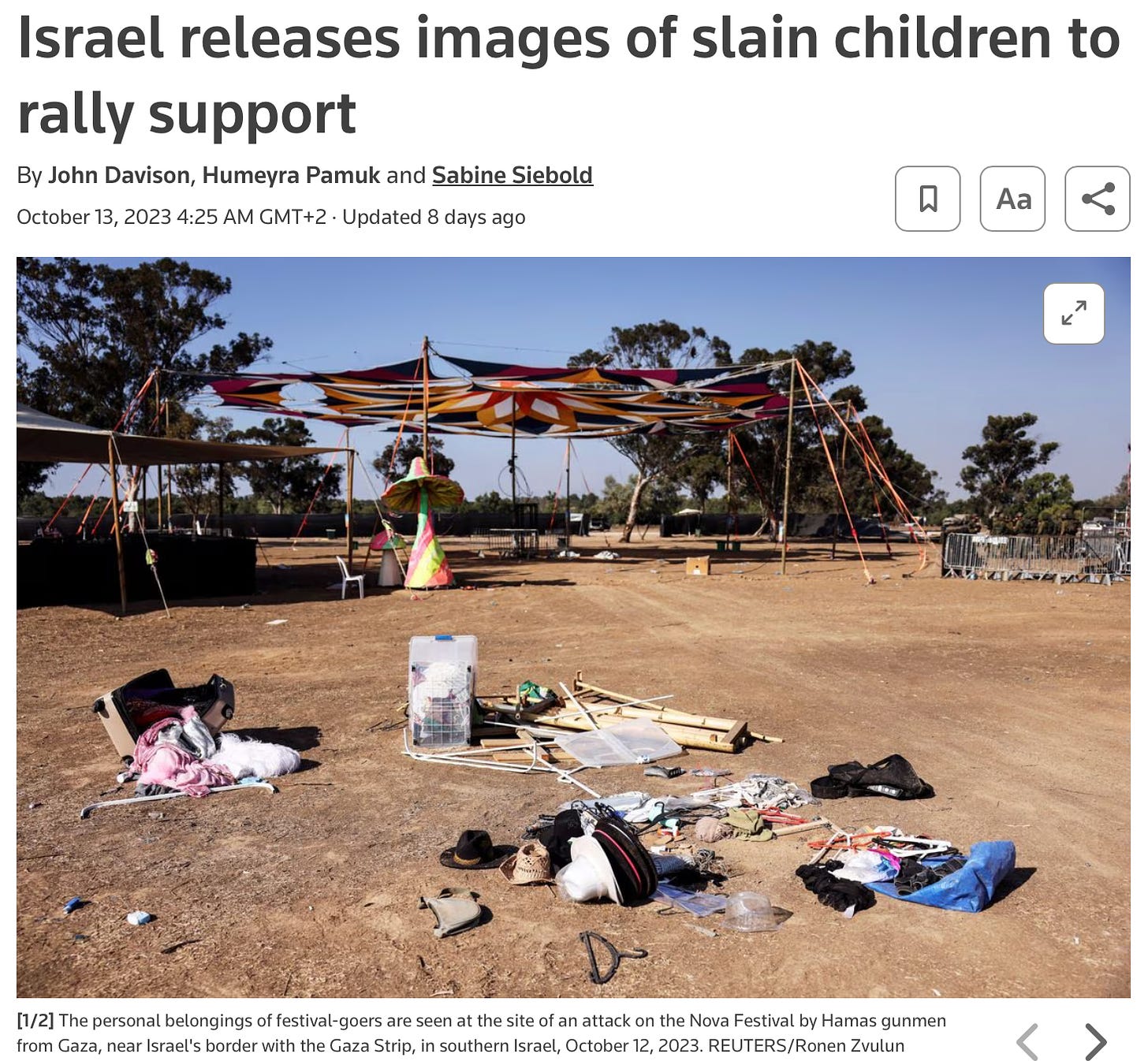Unconfirmed "Beheaded Babies" Report
Embedded IDF Journalist from i24 Helped Justify Israeli Slaughter

There’s perhaps no more serious a time for journalists to do their jobs responsibly than during a war.
But corporate media have not been, as evidenced by their repetition of the shocking, unsubstantiated claim that Hamas had beheaded 40 babies in its violent attack on a kibbutz in southern Israel on 7 October.
It all started with television reporting by journalist Nicole Zedek, who works for the 24-hour Israeli cable news channel i24, now embedded with the Israeli Defense Forces. In one 10 October report, she said, “I’m talking to some of the soldiers, and they say what they’ve witnessed…babies, their heads cut off.” In another report later that day, she says, “About 40 babies at least were taken out on gurneys,” prompting the host to interject: “Nicole, I have to cut in—that’s such a shocking, jarring statement there…. You’re saying 40 babies, dead babies?”
Zedek’s reporting was cobbled together into the viral claim that 40 babies were beheaded, despite that, by her own account, she had not seen the bodies herself, and relied solely on Israeli Defense Forces (IDF) soldiers as her sources. This might not have mattered as much if she were reporting on a less inflammatory subject, or had a more reliable source, but the IDF is known for misleading journalists.
The next day, Zedek told a podcast (Clay Travis and Buck Sexton Show, 10/11/23) that “it’s sickening” that people were scrutinizing her reporting of alleged baby beheadings closely: “We have these soldiers confirming what they’ve seen of the mutilation of these children.”
The claim remains up on i24’s website, as of 18 October. Israel’s largest newspaper Ha’aretz (12/2/19) found in a 2019 investigation that i24 had compromised its integrity years earlier by becoming more pro-Netanyahu in order to obtain a broadcast license. It also reputedly has close ties to the Israeli military (Anadolu Ajansi, 10/11/23).
Amplifying the claim

But Zedek and i24 alone could not have produced the flood of social media posts about 40 decapitated babies. That took other outlets amplifying her “reporting” within hours, lending it further credibility and helping it go viral. Some typical headlines:
“IDF Says Hamas Fighters Killed and Decapitated Babies at One Kibbutz Near the Gaza Border” (Business Insider, 10.10.23)
“Hamas kills 40 Babies and Children—Beheading Some of Them—at Israeli Kibbutz: Report” (New York Post, 10.10.23)
“Israeli Forces Say They’ve Uncovered Evidence of Brutal Killings: ‘They Cut Heads of Children’” (The Hill, 10.10.23)
The British Daily Mail (10.10.23) got it all into the headline:
Hamas Terrorists “Beheaded Babies During Kibbutz Slaughter Where 40 Young Children Were Killed”: IDF Soldiers Reveal Families Were Killed in Their Bedrooms—”Not in War, Not a Battlefield… a Massacre’”
Later in the day, a Turkish news outlet (Anadolu Ajansi, 10.10.23) did what Zedek and others should have done in the first place, reporting the story rather than just repeating the sources’ claims. It called the Israeli Defense Forces and found that the military would not confirm the account—a minimal step that Zedek and the many outlets that repeated her claims should have taken, given the gravity of the charges.
But the damage had been done; by Wednesday, nearly a dozen British newspapers ran the i24 claims on their front pages. The Israeli government picked up the story and ran with it too, even as it wouldn’t confirm it. Eventually, US President Biden was caught saying that he had seen photos of decapitated infants when he had not; the White House was forced to issue an embarrassing “clarification.”
Why does it matter?

So we have a story, and that story was generated in a grossly irresponsible way, and then repeated over and over. But what proof do we have that the story is false? After all, even if it was reported badly, and repeated without additional substantiation, it might be true.
Aside from the questionable nature of the sourcing, there is circumstantial evidence that it is false. The Israeli government released horrific images of dead infants over social media (Reuters, 10/13/23). None of the photos showed any evidence of decapitated infants. If the Israeli government had proof that such a horrifying crime had been committed, and was willing to release other traumatic photos of dead infants, surely it would have also released the ones that backed up its claims?
Even with all this said, why does it matter? After all, other horrific crimes were committed in southern Israel. It matters because the war in Gaza was already underway when i24 reported on the “decapitated babies” story—about 260 children were killed in the Gaza Strip as of 10 October (AP, 10/10/23). To maintain lockstep international support, the IDF needed to differentiate its mass slaughter from Hamas’s violence–which it could only do by painting Hamas as sadistic, savage, subhuman. The claim about beheading babies was ideal for the job: a shocking story that served to turn off logic and critical thinking. Who wouldn’t want to avenge murdered, desecrated infants?
Such stories have worked in the past; when Iraq invaded Kuwait in 1991, George H.W. Bush repeated the claims of a 15-year-old Kuwaiti teen that she had seen Iraqi soldiers take babies in Kuwait out of incubators and leave them to die (Democracy Now!, 12/5/18). The teenager later turned out to be the daughter of the Kuwaiti ambassador to the US, and her claims to be fabrications orchestrated by a DC public relations firm hired by the Kuwaiti government.
In addition, the Israeli government explicitly attempted to draw an equation between Hamas and ISIS, noted for their use of decapitation as a tactic. This aspect of the claim evokes stereotypes of “barbaric” Muslims.
By credulously repeating the soldiers’ claims and Zedek’s reporting on them, countless outlets around the world have contributed to these harms. And the people who have suffered the most in the process are the million-plus children of Gaza.




